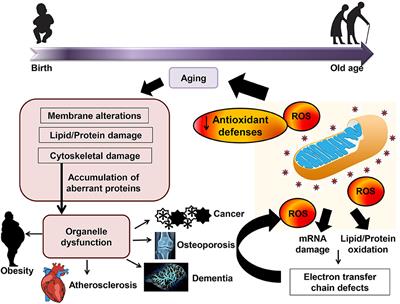Effect of antioxidant suplementation (vitamin C, vitamin E, carotenoids, polyphenols, etc.)
The beneficial effects of regular non-exhaustive physical exercise have been known for a long time. Exercise is part of the treatment of common diseases such as diabetes mellitus or coronary heart disease. It improves plasma lipid profile, increases bone density, and helps to lose weight. However, the beneficial effects of exercise are lost with exhaustive exercise and with a lack of training. Some of this damage is due to the production of free radicals. Exhaustive exercise causes muscle damage and inflammation, producing free radicals. Phagocytes, such as neuthrophyls, located in the inflamed area may all contribute to free radical production.
As a consecuence, oxidative stress occurs. Oxidative stress is a disturbance in the prooxidant-antioxidant balance in favor of the former, giving an overproduction of free radicals, causing insuffucient antioxidant defenses.
Exercise increases energy demands, increasing the oxygen consumption 10–20 times (200 times in active muscles). It is well known that one of the forms of radical production during exercise is due to a leak in the mitochondrial electron transport chain (ETC). Molecular oxygen typically reacts with species generated by single electron transfer. In such reactions, molecular oxygen is reduced by one electron to form a superoxide radical (O2– ).
Free radicals are chemical compounds produced in cells in a wide range of processes by reactive species oxygen (ROS) (superoxide, hidroxile, alcoxile, peroxile, hydrogen peroxide) and nitrogen (nitric oxide, nitrogen dioxide, peroxinitrile). Free radicals are widely thought to be of cardinal importance in effecting both the damage and the adaptation that accompany significant physical activity or exercise. They are reactive prooxidant agents to carbohydrates, proteins, and lipids
Submaximal long-duration exercise training may augment the physiological antioxidant defenses in several tissues. Antioxidant defenses can be enzimatic (SOD, GPx, and catalase) and non-enzimatic (glutation, vitamin C and E, carotenoids, lipoic acid, transferrine, and polyphenols).
The effect of antioxidant suplementation (vitamin C, vitamin E, carotenoids, polyphenols, etc.) in the oxidative stress during the exercise has been demonstrated. Within antioxidants, flavonoids are the most important polyphenolic compounds found in rich abundance in all land plants. Flavonoids often exhibit strong antioxidant properties due to its ability to trap free radicals. Furthermore, it is currently unclear whether regular vigorous exercise increases the need for dietary intake of antioxidants. Clearly, additional research that analyzes the antioxidant requirements of individual athletes is needed. This controversy may be due to different reasons: age and sex, training methods, differences in biomaker analysis methods, etc.
Chronic exercise also leads to the upregulation of the body’s antioxidant defence mechanism, which helps minimize the oxidative stress that may occur after an acute bout of exercise. Recent studies show a beneficial role of the reactive species, produced during a bout of exercise, that lead to important training adaptations: angiogenesis, mitochondria biogenesis, and muscle hypertrophy. The adaptations occur depending on the mechanic, and consequently biochemical, stimulus within the muscle. This is a new area of study that promises important findings in the sphere of molecular and cellular mechanisms involved in the relationship between oxidative stress and exercise.
Healthy exercise is being done on a regular basis (several days a week) at a moderate intensity so that the human body in its capacity for homeostatic adaptation (with this type of exercise) increases the physiological antioxidant defenses (enzyme systems such as glutathione peroxidase, catalase, superoxide dismutase), and will offset the appearance of oxidizing species upon exercise (radical and non-radical) with this increased enzyme activity; however, the exercise leads to an increase in the oxidative body state. When more oxidizing species are generated, the body can counteract the so-called oxidative stress, which appears to be unhealthy. If the body does not sufficiently increase the physiological antioxidant defense, it is necessary to provide these through dietary antioxidants such as those included in fruits and vegetables.
Brites et al. (1999) observed an increase in plasma levels of low molecular weight antioxidants (ascorbic acid, uric acid, and α-tocopherol) in a group of trained players to sedentary controls. This increase can be attributed to a mobilization of these antioxidants from tissues into plasma, which would justify the improvement of the total plasma antioxidant status with training.
It would actually be very convenient for researchers, clinicians, coaches, etc. if optimal levels for relevant parameters would be decided and are available, but to date, and for a number of reasons, there are no clear data, such as definite reference intervals. The best practice seems to be thefrequent monitoring, comparison of the individualized values, and relative assessment of the training settings.
The optimal response to training would be the achievement of the relevant adaptations, such as the enhancement of the antioxidant capacity and the subsequent health improvement. Well-designed exercise training is regarded as a preferred way to attain these benefits.




Reblogged this on Stimulife.blog and commented:
https://stimulife.blog/2020/05/17/strategies-of-antioxidant-defence/
👍🙂grt
Here is a link for knowing high antioxidant property with herbal plant.
https://healthjaagran.com/2020/05/24/importance-of-tulsi-herb-immunity-booster/
Also here Jaagran. https://us.foursigmatic.com/become-an-affiliate?rfsn=4440262.1d6b88&discount=STIMULIFE
Just want to say your article is as astonishing. The clearness in your post is simply greatand that i can suppose you are a professional on this subject.Fine along with your permission allow me to snatch your feed to stay updated with impending post.Thank you one million and please continue the rewarding work.my web page; full body showerhi there, your article is perfect.Following your articles.Real nice design and great articles, nothing else we wanteekekeeddfddHello There. I found your blog the use ofmsn. That is a really smartly written article. I’ll make sureto bookmark it and come back to learn more of your helpful info.Thank you for the post. I will definitely comeback.I truly appreciate this blog post. Much thanks again. Cool. Jemie Bax Meridel